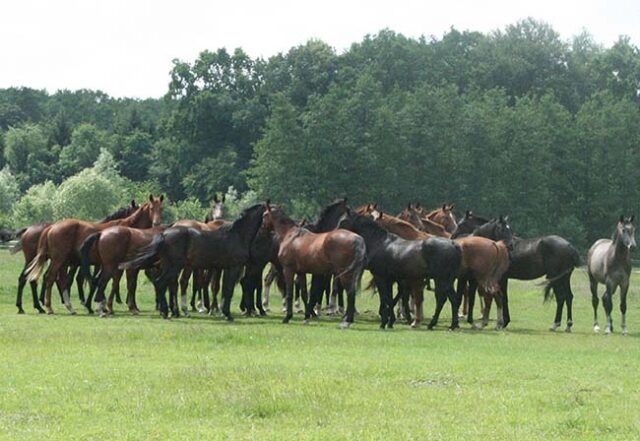By Rodrigo Arruda de Oliveira and Christine Aurich Dr.Med.Vet.
Photography/Graphics: provided by the authors
Risk prevention is often counterproductive to stallions’ living conditions when assessed under welfare aspects. In the wild, stallions live in social groups, but under domestic conditions, the majority of breeding stallions live in individual boxes with limited social contact.
This stimulates aggressiveness and the incidence of stereotypic behavior. While racehorse stallions start their breeding career after having finished their performance career, riding horse stallions are often simultaneously used for breeding and performance. Training, performance, and the associated stress are unlikely to impair semen characteristics, but performing stallions may benefit from more opportunities for social contact.
With regard to accommodation of stallions in single boxes, changes in the construction of the partition between them may help to improve social contact from merely visual to much more physical. This will help to reduce social isolation but requires careful observation if neighbors tend to either sympathize or fight with each other. Careful organization of the barn is thus of great importance. Under certain conditions, even keeping adult stallions in groups on spacious pastures is possible.
Interestingly, the frequency of agonistic interactions usually decreases quickly and remains low after successful group integration. General changes in the husbandry of young stallions and at their transfer into the future career may help to produce stallions with better social skills and facilitate accommodation under improved welfare conditions.
Introduction
Stallions are the focal point of equine breeding programs. They are selected based on either pedigree, performance, conformation, or a combination of these. Individual stallions may become extremely popular with breeders because of their own or their offsprings’ performance which may result in an over average influence on development of a certain breed. The number of mares bred per season and the breeding fee of some stallions may therefore be extraordinarily high. In conclusion, individual stallions will achieve a high monetary value. This is, however, often a burden to the animal because risk prevention is counterproductive to living conditions of horses when assessed under welfare aspects.
Under wildlife conditions, stallions live in social groups either as a dominant male, i.e., a so-called harem stallion in a group of females and their foals, or in a group of bachelor stallions [1,2]. Thus, stallions spend only a very limited time of the day alone [3]. In contrast, under domestic conditions adult stallions are usually housed in individual box stalls to reduce injuries and - when used as semen donors - also for sanitary reasons [4,5]. Physiological sexual behavior in male individuals – irrespective of species – to a certain extent includes aggressive behavior and may even be associated with unmanageable sexual drive or activity. Handling of stallions can therefore represent a serious safety concern and may complicate animal husbandry considerably [6]. Social interaction of stallions with other horses is therefore often strongly restricted. Contact to mares is usually completely absent or reduced to the time spent in hand for natural mating or semen collection, respectively [7]. The restrictions of social contact in stallions may seriously affect their libido and sexual performance [8,9]. Prevention of both, access to pasture grazing as well contact to conspecifics are prejudicial to the welfare of herbivore and highly social animals like horses [10,11,12]. The increased incidence of aggressive behavior and stereotypies in stallions is suggested a consequence [2,10]... To read the complete article you need to be a subscriber
CLICK HERE TO SUBSCRIBE TO BREEDING NEWS
SUBSCRIBERS CAN READ THE COMPLETE ARTICLE BY LOGGING IN AND RETURNING TO THIS PAGE




